Tesla Model 3: Cooling System (Drain and Refill)
Cooling System - Remove
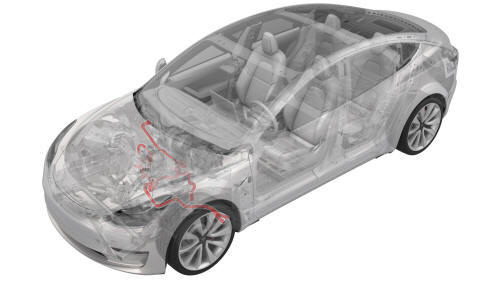
Remove
- Remove the 2nd row lower seat cushion. See Seat Cushion - Lower - 2nd
Row (Remove and Replace).
- Remove the rear underhood apron. See Underhood Apron - Rear (Remove and
Replace).
- Remove the cabin intake duct. See Duct - Cabin Intake (Remove and
Replace).
- Disconnect 12V power. See 12V Power (Disconnect and Connect).
- Remove the front aero shield. See Panel - Aero Shield - Front (Remove
and Replace).
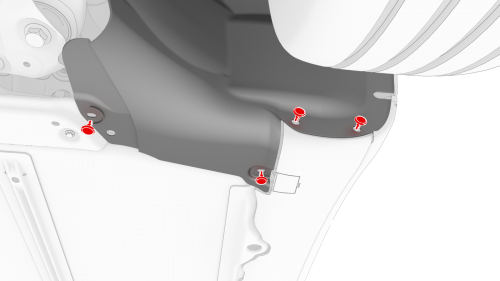
LH side shown, RH similar
- Release the push clips that attach the lower rear edge of the LH and RH
wheel liners to the vehicle for access to the coolant hose.
- Pull the LH and RH wheel liners back, and then attach the liners to the
subframe with bungee straps.
- Position the coolant drain container underneath the RH front side of the
HV battery.
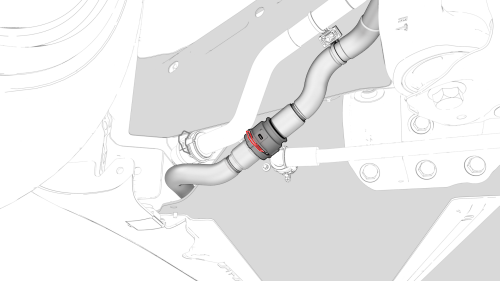
- Release the spring clip to disconnect the powertrain return hose at the
RH side of the vehicle, and then plug the female side of the hose.
- Attach a powertrain drain fitting adapter to the male side of the
powertrain return hose, and then attach a hose extension to the adapter
- Attach the hose extension to the coolant cart drain hose.
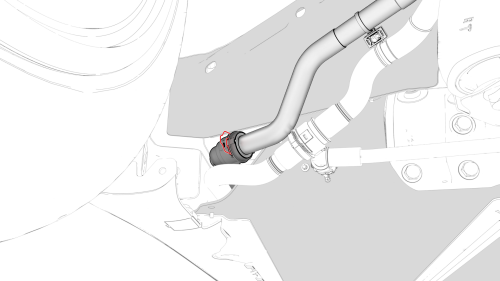
- Release the spring clip to disconnect the rear powertrain supply hose at
the RH side of the vehicle, and then plug the male side of the hose.
- Attach a powertrain flush fitting adapter to the female side of the rear
powertrain supply hose.
- Attach the powertrain flush fitting adapter to the coolant pressure
tester on the coolant cart, and then preset the pressure regulator valve.
- Attach a compressed air line to the coolant pressure tester.
Note: Make sure the valve on the pressure regulator is closed.
- Open the valve on the powertrain drain fitting adapter.
- Slowly open the valve on the pressure regulator and allow coolant to
drain out of the powertrain return hose
- Close the valve on the pressure regulator when no more coolant is
draining from the powertrain return hose
- Remove the powertrain flush fitting adapter from the female side of the
powertrain supply hose.
- Remove the powertrain drain fitting adapter from the male side of the
powertrain return hose.
- Remove the plugs and attach the spring clips (x2) to reconnect both
powertrain coolant hoses.
- Remove the powertrain drain fitting adapter from the cart drain hose,
and then remove the powertrain flush fitting adapter from the cart pressure
hose.
- Position the coolant drain container underneath the LH front side of the
HV battery.
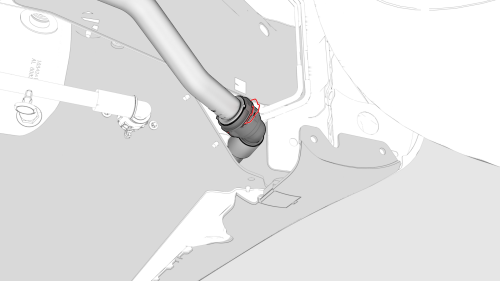
- Release the spring clip to disconnect the HV battery return hose at the
LH side of the vehicle, and then plug the male side of the hose.
- Attach the battery drain fitting adapter to the female side of the HV
battery return hose, and then attach the battery drain fitting adapter to
the coolant cart drain hose.
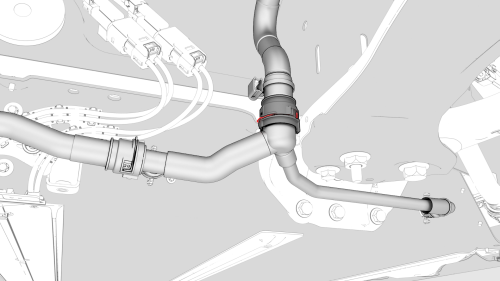
- Release the spring clip to disconnect the HV battery supply hose, and
then plug female side of the hose.
.png)
- Release the clips that attach the chiller hose to the body.
- Attach a battery flush fitting adapter to the male side of the HV
battery supply hose.
- Attach the battery flush fitting adapter to the coolant cart pressure
hose.
- Open the valve on the battery drain fitting adapter.
- Slowly open the valve on the pressure regulator and allow coolant to
drain out of the HV battery return hose.
- Close the valve on the pressure regulator when no more coolant is
draining from the HV battery return hose
- Disconnect the compressed air line from the coolant pressure tester.
- Remove the battery drain fitting adapter from the female side of the HV
battery return hose.
- Remove the battery flush fitting adapter from the male side of the HV
battery supply hose.

- Remove the plug and reconnect the HV battery to battery chiller hoses.

- Remove the plug and reconnect the HV battery return hose.
.png)
- Install the clips that attach the battery chiller hose to the body.
- Remove the coolant drain container from underneath the vehicle.
- Remove the battery drain fitting adapter from the cart drain hose, and
then remove the battery flush fitting adapter from the cart pressure hose.
Cooling System - Procedure
Procedure

LH side shown, RH similar
- Release the bungee straps and install the push clips that attach the
lower rear edge of the LH and RH front wheel liners to the vehicle.
- Install the front aero shield. See Panel - Aero Shield - Front (Remove
and Replace).
- Connect 12V power. See 12V Power (Disconnect and Connect).
- Connect a laptop with Toolbox to the vehicle.
- Type "thermal" into the search field.
Note: Make sure "Actions" is selected if not already.
- Click the play button next to "PROC_VCFRONT_X_THERMAL-FILL-DRAIN", and
then select Run
- Remove the outer HVAC plenum duct. See Duct - HVAC Plenum - Outer
(Remove and Replace).
- Remove the cap from the superbottle reservoir.
- Fill a container with at least 15 L of coolant, and then place the
container into the front storage area.
- Fully submerge the coolant refill hose into the coolant container.
- Attach the vacuum refill tool to the superbottle.
Note: Use a cone shaped adapter to ensure vacuum will be pulled
from the lower chamber.
- Make sure the coolant refill valve and the air inlet valve are both
closed.
- Place the end of the overflow hose into an empty container.
- Connect shop air supply to the vacuum refill tool and set the minimum
pressure to 5.5 bar (80 PSI).
- Open the air inlet valve for 10 seconds to allow the vacuum tool to
evacuate the cooling system and create a vacuum.
- Slowly open the coolant refill valve to allow coolant to be drawn into
the coolant refill hose. Close the valve when the hose is full of coolant.
Note: This purges trapped air from the hose.
- Monitor the gauge for 30 seconds to verify a vacuum is maintained in the
cooling system.
- Reopen the air inlet valve for 3 minutes to evacuate the cooling system,
and then close the valve.
- Slowly open the coolant refill valve to allow coolant to be drawn in the
cooling system. When the gauge stops moving, close the coolant refill valve.
Note: Make sure the end of the coolant refill hose is fully
submerged during the entire process.
- Lift the coolant refill tool from the reservoir and hold above the
coolant container to allow excess coolant to drain.
- Disconnect the shop air supply from the coolant refill tool.
- Remove both coolant containers from the front storage area.
- Type "vcfront" into the search field.
- Click the play button next to "TEST-RESET_VCFRONT", and then select Run.
- Click the play button next to
"TEST_VCFRONT_X_THERMAL-COOLANT-AIR-PURGE", and then select Run.
Note: Make sure that the drive rails are off. Turning on the drive
rail will stop the routine.
Note: The test lasts approximately 10 minutes.
Note: Test will vary speeds from 3,500 to 6,500 RPM,
viewable under the PT Thermal tab.
Note: If speeds hover at around 7,000 RPM, the pumps are air
locked. Go to step 9 and perform the vacuum fill again.
- Inspect coolant level and top off if necessary.
Install
- Install the cap on the superbottle reservoir.
- Install the outer HVAC plenum duct. See Duct - HVAC Plenum - Outer
(Remove and Replace).
- Install the cabin intake duct. See Duct - Cabin Intake (Remove and
Replace).
- Install the rear underhood apron. See Underhood Apron - Rear (Remove and
Replace).
- Install the 2nd row lower seat cushion. See Seat Cushion - Lower - 2nd
Row (Remove and Replace)
READ NEXT:
DRAFT
Warning:
This procedure was derived from pre-production computer models, and
might not reflect the real-world situation. Warnings and cautions might be
missing. Follow safety requirements and
SEE MORE:
Remove
Raise and support the vehicle on a 2 post lift. See
Raise Vehicle - 2 Post Lift.
Remove the LH rear wheel. See Wheel (Remove and
Install).
Overview of Climate Controls
Climate controls are always available at the bottom of the touchscreen. To
turn the climate control
system on, touch the fan icon or adjust the cabin temperature. To turn it off,
touch the fan icon
and then touch the off button near the center of the popup window.






.png)


.png)


